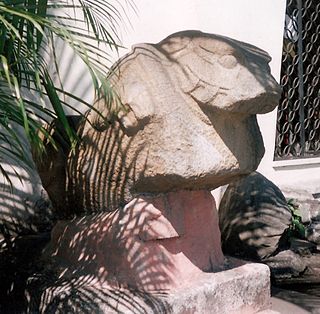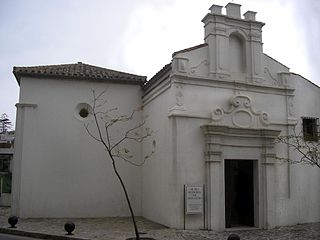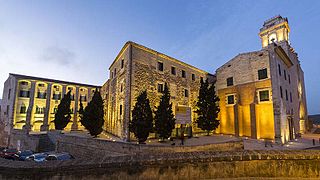
Córdoba, or Cordova in English, is a city in Andalusia, southern Spain, and the capital of the province of Córdoba. It is the third most populated municipality in Andalusia, after Seville and Málaga, and the 11th overall in the country.
Algeciras is a municipality of Spain belonging to the province of Cádiz, Andalusia. Located in the southern end of the Iberian Peninsula, near the Strait of Gibraltar, it is the largest city on the Bay of Gibraltar. The Port of Algeciras is one of the largest ports in Europe and the world in three categories: container, cargo and transshipment. The urban area straddles the small Río de la Miel, which is the southernmost river of continental Europe. As of 1 January 2020, the municipality had a registered population of 123,078, second in its province after Jerez de la Frontera and greater than Cádiz city population. It forms part of the comarca of Campo de Gibraltar.

Marbella is a city and municipality in southern Spain, belonging to the province of Málaga in the autonomous community of Andalusia. It is part of the Costa del Sol and is the headquarters of the Association of Municipalities of the region; it is also the head of the judicial district that bears its name.

The Museum of Gold is a museum located in Bogotá, Colombia. It is one of the most visited touristic highlights in the country. The museum receives around 500,000 tourists per year.

Chiclana de la Frontera is a town and municipality in southwestern Spain, in the province of Cádiz, Andalucía, near the Gulf of Cádiz. It belongs to the association of municipalities of the Bay of Cádiz, the provincial capital of Cádiz, Jerez de la Frontera, San Fernando, El Puerto de Santa María, Puerto Real and Rota which form the third largest metropolitan area in Andalusia, behind Seville and Málaga, and the twelfth largest in Spain. It is located 20 kilometres south-east from Cádiz, and borders the municipalities of San Fernando and Puerto Real to the north. In 1877, the municipality's population was 11,677; in 2012, it was 81,473. It has a surface area is 203 square kilometres (78 sq mi) and a population density of 401 inhabitants / km2. The average elevation is 11 metres (36 ft) above sea level. The economy depends largely upon modern industry, especially salt processing and tourism, and the municipality is known for its beaches such as the 6 kilometres (3.7 mi) long Playa de la Barrosa, hotels and golf courses in the resort of Novo Sancti Petri. The municipality contains the largest number of hotel beds in the Province of Cádiz and the Costa de la Luz. The town's newspaper, Chiclana Información, is distributed on Saturday mornings.

The Plaza de España is a plaza in the Parque de María Luisa, in Seville, Spain. It was built in 1928 for the Ibero-American Exposition of 1929. It is a landmark example of Regionalism Architecture, mixing elements of the Baroque Revival, Renaissance Revival and Moorish Revival (Neo-Mudéjar) styles of Spanish architecture.

The National Archaeological Museum is a museum in Madrid, Spain. It is located on Calle de Serrano beside the Plaza de Colón, sharing its building with the National Library of Spain.

The Chapel of Our Lady of Europe is a Roman Catholic chapel located in the High Square of Algeciras (Spain). The popularly known "Capillita de Europa" is considered as the foundational element of the modern city of Algeciras. It was the host of the statue of the Virgin and the Child kept in the Shrine of Our Lady of Europe from the capture of Gibraltar by the Anglo-Dutch fleet in 1704 to 1864.

Museo de la Naturaleza y Arqueología (MUNA), is a museum-based in Santa Cruz de Tenerife, Tenerife,. It contains many significant archaeological finds and is considered the best repository of objects from the Pre-Castilian Canary Islands. The museum also houses significant paleontological, botanical, entomological, and marine and terrestrial vertebrate collections, and is considered the best Natural Library of the Canary Islands.

The La Plata Museum is a natural history museum in La Plata, Argentina. It is part of the Facultad de Ciencias Naturales y Museo of the UNLP.

The Archeological Museum of Seville is a museum in Seville, southern Spain, housed in the Pabellón del Renacimiento, one of the pavilions designed by the architect Aníbal González. These pavilions at the Plaza de España were created for the Ibero-American Exposition of 1929.

The Museo Regional de Arqueología de la Democracia is an archaeological museum in the municipality of La Democracia in the department of Escuintla in Guatemala. The museum displays pre-Columbian Mesoamerican artefacts from the Pacific lowlands datingfrom the Preclassic Period through to the Postclassic Period, with a particular emphasis upon the local Monte Alto culture. The museum is open from Tuesday through to Saturday from 8 am to 4 pm.

The Museo Miraflores is an archaeological museum in Guatemala City, dedicated to the display of artefacts from the ancient Maya city of Kaminaljuyu. The museum is open from Tuesday through to Sunday.

Museo Municipal Taurino Francisco Montes is located in Chiclana de la Frontera, in the province of Cádiz, Andalusia, southwestern Spain. Situated on San Agustín Street, the bullfighting museum is dedicated to the matador Francisco Montes Reina (1805–1851), nicknamed "Paquiro", who was born in this town. He is considered the most important 19th century bullfighter, because of his skill at the sport, on foot or on horseback. The bullfighting displays include pieces of great historical and artistic value. It was inaugurated in 2003 and founded by Pedro Leal Aragon who for seven years collected objects, souvenirs and bullfighting implements. One of its first events was a group show of the artists Antonio Vela, Carlos Quevedo, and Paloma Garcia. After a renovation, it re-opened in June 2005 with miniature models of the bullring in Ronda, a head bust of Paquiro, and an original painting by Antonio Cavanna.The expansion also housed Spain's most important bullfighting collection, Collection Sagnier, which was acquired by the city to improve the historical and artistic quality of the municipal bullfighting museum. There are four rooms: bullfighting origins, Paquiro and his time, contemporary bullfighting, and the bull and the arts. The museum's garden is used for book presentations, press conferences, weddings and small concerts. It is closed on Sundays.

Capilla del Cristo de la Alameda is a chapel in Algeciras, Spain. It was built in 1776 at the initiative of the priest Domingo Perez. The building was then situated along one of Algeciras's main streets of the time, Calle Alameda, and was attended by many sailors entering the port. In 1931 the church was assaulted and in subsequent years was converted into a storehouse and then an auto repair shop until the late 1990s when the city recovered it and it became the headquarters of the Municipal Museum of Sacred Art. The chapel consists of a single room and a small sacristy, and has a Baroque gabled facade.

The Palacio Municipal de Caracas, or Consejo Municipal de Caracas, is the city hall of Caracas, Venezuela. It is located on the corner of Gradillas a Monjas opposite the Plaza Bolívar, occupying half of the plaza's southern section. The building dates from the seventeenth century but now bears the mark of Alejandro Chataing's Neoclassical additions in 1906. It was the focal point for the Constitutional Convention, and signing of the Declaration of Independence in the nineteenth century. The present building is the result of the work undertaken by the Venezuelan architect Alejandro Chataing in 1906. The west wing of the building, the Capilla de Santa Rosa de Lima, the chapel where Venezuela's independence was declared in 1811, has been fully restored and furnished with authentic period pieces. The ground floor houses the Museo Caracas, which contains works by Venezuela's most celebrated painters and many other historic artifacts. It was declared a National Historic Landmark on 16 February 1979.

Museu de Menorca is a public institution located in the city of Mahón, Balearic Islands, Spain, which is devoted to the research and diffusion of the prehistory and history of Menorca.

The Pontevedra Museum,, is a museum in the Galician city of Pontevedra in Spain. It was founded by the Deputation of Pontevedra on 30 December 1927 and has six buildings for its exhibitions.

The Municipal History Museum of Écija is a history museum in Écija, Spain, mainly dedicated to archaeology.

























